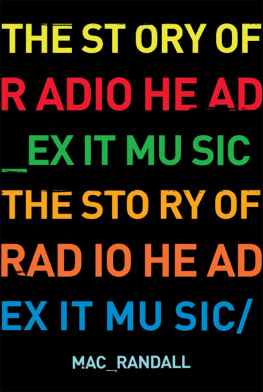EVERYTHING IN ITS RIGHT PLACE
Everything in its Right Place
ANALYZING RADIOHEAD
Brad Osborn


Oxford University Press is a department of the University of Oxford. It furthers the Universitys objective of excellence in research, scholarship, and education by publishing worldwide. Oxford is a registered trade mark of Oxford University Press in the UK and certain other countries.
Published in the United States of America by Oxford University Press
198 Madison Avenue, New York, NY 10016, United States of America.
Oxford University Press 2017
All rights reserved. No part of this publication may be reproduced, stored in a retrieval system, or transmitted, in any form or by any means, without the prior permission in writing of Oxford University Press, or as expressly permitted by law, by license, or under terms agreed with the appropriate reproduction rights organization. Inquiries concerning reproduction outside the scope of the above should be sent to the Rights Department, Oxford University Press, at the address above.
You must not circulate this work in any other form and you must impose this same condition on any acquirer.
Library of Congress Cataloging-in-Publication Data
Names: Osborn, Brad.Title: Everything in its right place: analyzing Radiohead/Brad Osborn.
Description: New York: Oxford University Press, [2017] | Includes bibliographical references and index.
Identifiers: LCCN 2016022990 (print) | LCCN 2016023712 (ebook) | ISBN 9780190629236 (pbk.: alk. paper) | ISBN 9780190629229 (hardcover: alk. paper) | ISBN 9780190629243 (updf) | ISBN 9780190629250 (epub) Subjects: LCSH: Radiohead (Musical group)Criticism and interpretation | Rock musicEnglandHistory and criticism. Classification: LCC ML421.R25 O83 2017 (print) | LCC ML421.R25 (ebook) | DDC 782.42166092/2dc23 LC record available at https://lccn.loc.gov/2016022990
Contents
SINCE OK COMPUTER (1997), five of the six records released by the English rock band Radiohead has peaked at #1 on the UK and/or US charts, and these six records have accounted for nearly 26 million of the bands 30 million albums sold. This success in their mature period (19972011) is especially notable since, following the generic Brit Pop and Alternative Rock heard on their first two albums (1993s Pablo Honey and 1995s The Bends), the bands sound has never piggybacked on any mainstream trends. Their commercial success in this mature period stems instead from an ability to write music that balances expectation and surprise. Though most of their songs present the listener with myriad surprises and disjunctures, they only do so after first setting up rich expectations listeners have inherited from various musical traditions.
This book analyzes Radioheads studio albums from OK Computer (1997) through The King of Limbs (2011) to reveal this balance in four musical parameters: (1) song form, (2) rhythm, (3) timbre, and (4) harmony. Songs often begin as if they were in standard verse/chorus form only to replace the expected final chorus with a radically new section at the songs conclusion. Rhythms that initially suggest a standard rock backbeat become stretched or cropped to the point of deforming standard  meters. Radioheads music, qua rock music, relies on guitar, bass, drums, and tenor vocal, but those timbres are often digitally manipulated in a manner that disguises the source instrument. Finally, most Radiohead songs exhibit the same Western tonality as Mozart, The Beatles, and childrens songs, but dissonant notes do not always resolve in expected ways.
meters. Radioheads music, qua rock music, relies on guitar, bass, drums, and tenor vocal, but those timbres are often digitally manipulated in a manner that disguises the source instrument. Finally, most Radiohead songs exhibit the same Western tonality as Mozart, The Beatles, and childrens songs, but dissonant notes do not always resolve in expected ways.
Expanding on recent work in perception, this book approaches Radioheads recorded music as a sonic ecosystem in which listeners participate, react, and adapt in order to search for meaning. Listeners bring into these ecosystems a set of expectations learned (if only tacitly) from popular music, classical music, or even Radioheads own compositional idiolect, which is largely the product of the bands primary songwriter and lyricist Thom Yorke. Particularly important to this perceptual process are moments in Radioheads music where a certain expectationformal, rhythmic, timbral, or harmonicis strongly cued through recognizable musical stimuli only to be violated by an unexpected realization. Of course, these expectations and realizations are contingent on ones musical background. An augmented sixth chord suggests one continuation to a classical aficionado but quite a different one to a jazz pianist. Hemiola is a novel and fleeting surface rhythm to a baroque oboe soloist but forms the basic meter of entire pieces in post-millennial rock and Ghanaian drumming. Violations of these subjective expectationrealization chains prompt the listener to search more deeply for meaning. Linking these musical details to the corresponding lyrics is often the first step in meaning creation, but an individual listeners search for meaning can also involve biographical details of the band or intertextual relationships with music, literature, or film.
ORGANIZATIONAL LAYOUT
Following the preface, an opening chapter lays out some methodological premises based on ecological perception and semiotics, and argues why Radioheads music, more than any other commercially viable rock band in the past two decades, deserves such careful study. The book then proceeds through four intensely analytical chapters, each reflecting one of the four parameters named above. Following each of these chapters is a short analytical coda. Whereas the chapters themselves focus on situating many short examples within Radioheads catalog, the coda synthesizes the approaches provided in the chapter to illuminate a more comprehensive and interpretive view of one song as a whole. The final chapter animates the theoretical groundwork laid throughout the book in a sustained analysis of one of the bands most popular songs, Pyramid Song, showing how the same strategies can be used to analyze music videos.
cognitive arousal is maximized by music that meets us somewhere between the expected and the unexpected. Put differently, the brain goes into overdrive when music presents a stimulus that at once draws upon our prior experiences and yet provides some novel twist. In relating this observation to semiotic theory, I suggest Radioheads balancing of surprise and expectation in form, rhythm, timbre, and harmonythe very balancing act that maximizes a hyperactive cognitive spacecan be described in terms of salience. Like Beethovens late music, Radioheads albums between 1997 and 2011 maximize salience by building upon a host of expectations inherited from classical and popular music while at the same time subverting those expectations several times over the course of a given song. After building a case for how Radioheads music is so consistently salient in this mature period, the chapter ends with a comparison with the more predictableand therefore less perceptually markedtwo albums that precede this period.
Rock music carries with it a set of formal expectations inherited from the late 1950s (strophic forms), which were transformed by The Beatles and other artists in the late 1960s (verse/chorus). These have remained almost completely unchanged in conventional rock music over the past four decades. begins by demonstrating these conventional song forms in a handful of Radiohead songs. However, many of their songs begin as a strophic form (AA) or verse/chorus form (ABAB) but replace the expected final chorus with a brand new section of climactic material. The resulting song structure, which I call terminally climactic form, does not appear with any frequency in rock music until after 1990. Radioheads use of this song form is thus not uniqueit situates them within an emergent post-millennial formal trendbut the frequency with which they use it is unparalleled. This is notable because the terminally climactic form, in presenting listeners with a very strong sense of expectation (final chorus) only to subvert that expectation with a surprise realization (terminal climax), which










 meters. Radioheads music, qua rock music, relies on guitar, bass, drums, and tenor vocal, but those timbres are often digitally manipulated in a manner that disguises the source instrument. Finally, most Radiohead songs exhibit the same Western tonality as Mozart, The Beatles, and childrens songs, but dissonant notes do not always resolve in expected ways.
meters. Radioheads music, qua rock music, relies on guitar, bass, drums, and tenor vocal, but those timbres are often digitally manipulated in a manner that disguises the source instrument. Finally, most Radiohead songs exhibit the same Western tonality as Mozart, The Beatles, and childrens songs, but dissonant notes do not always resolve in expected ways.